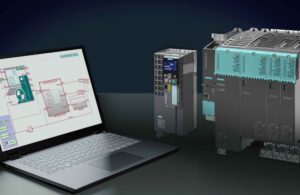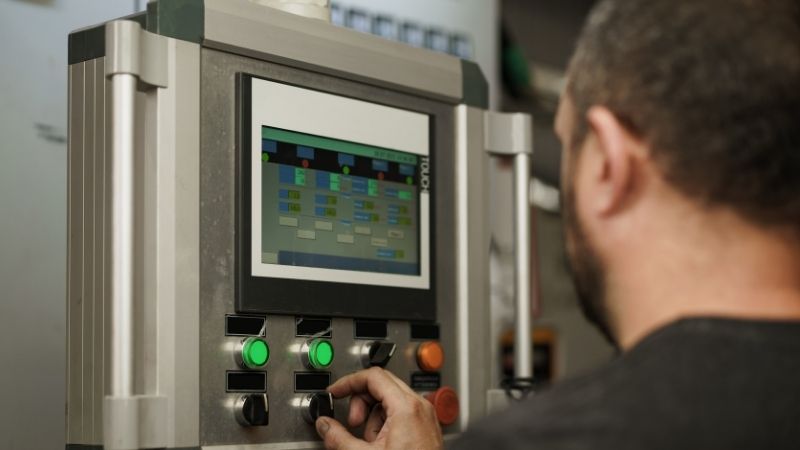Wie steuert eine SPS ein Magnetventil?
Glücklicherweise kann mit einem speicherprogrammierbaren Controller (SPS) kann diesen Prozess rationalisieren und für Präzision und Effizienz sorgen.
Als Ingenieur bei Kwoco habe ich aus erster Hand gesehen, wie SPS Automatisierungsaufgaben vereinfachen. Indem wir eine SPS an ein Magnetventil anschließen, können wir Vorgänge automatisieren, die sonst manuelle Eingriffe erfordern würden. Das spart nicht nur Zeit, sondern erhöht auch die Sicherheit in potenziell gefährlichen Umgebungen.
Inhaltsverzeichnis
Was ist ein Magnetventil?
Ein Magnetventil ist ein elektromechanisches Gerät, das den Durchfluss von Flüssigkeiten und Gasen steuert. Es besteht aus zwei Hauptteilen: einer Magnetspule und einem Ventilkörper. Je nach Ausführung kann ein Magnetventil normalerweise offen (NO) oder normalerweise geschlossen (NC) sein. Dies bedeutet, dass es den Flüssigkeitsfluss entweder zulässt oder blockiert, ohne dass ständige manuelle Anpassungen erforderlich sind.
Wenn die Magnetspule aktiviert wird, erzeugt sie ein Magnetfeld, das den Kolben im Ventilkörper bewegt. Diese Aktion öffnet oder schließt das Ventil und steuert den Medienfluss. Das Verständnis dieses Mechanismus ist für jeden Ingenieur, der an Flüssigkeitssteuerungssystemen arbeitet, von wesentlicher Bedeutung.
Welche Faktoren sollten Sie bei der Auswahl eines Magnetventils berücksichtigen?
Bei der Auswahl eines Magnetventils sind Sie möglicherweise von der Auswahl überwältigt. Die Wahl des richtigen Ventils ist entscheidend, da die falsche Wahl zu Betriebsineffizienzen und höheren Kosten führen kann. Wenn Sie wissen, worauf Sie achten müssen, kann dieser Prozess vereinfacht werden.
Vereinfacht ausgedrückt sind hier die wichtigsten zu berücksichtigenden Faktoren:
- Magnetventiltyp: Überlegen Sie, ob Sie ein Zweiwege-, Dreiwege- oder Vierwegeventil benötigen. Dies hängt von Ihrer Anwendung und der gewünschten Durchflussregelung ab.
- Betriebsdruck und Temperatur: Stellen Sie sicher, dass das Ventil den Druck- und Temperaturbedingungen Ihres Systems standhält. Das Überschreiten dieser Grenzwerte kann zu einem Ventilausfall oder einem unsicheren Betrieb führen.
- Medienkompatibilität: Stellen Sie sicher, dass das Ventilmaterial mit den zu steuernden Flüssigkeiten oder Gasen kompatibel ist. Chemische Reaktionen, die das Ventil beschädigen könnten, müssen unbedingt vermieden werden.
- Spannungsanforderungen: Bestimmen Sie, ob Sie ein AC- oder DC-Ventil benötigen, und prüfen Sie die für den Betrieb erforderliche Spannung. Dies kann sich auf die Installation und Integration in Ihre vorhandenen Systeme auswirken.
- Ansprechzeit: Berücksichtigen Sie bei Anwendungen, die eine schnelle Betätigung erfordern, die Reaktionszeit des Ventils. Dies kann sich auf die Gesamteffizienz Ihres Systems auswirken.
- Größe und Durchflussrate: Die Ventilgröße muss zu Ihrem Rohrleitungssystem passen und die Durchflussrate muss den Anforderungen Ihrer Anwendung entsprechen. Falsch dimensionierte Ventile können die Effizienz verringern oder den Verschleiß erhöhen.
- Qualität und Zuverlässigkeit: Wählen Sie Ventile von renommierten Herstellern, die für ihre Qualität bekannt sind. Qualität wirkt sich auf Wartungskosten und Betriebszuverlässigkeit aus.
- Kosten vs. Wert: Budgetbeschränkungen sind zwar wichtig, aber bedenken Sie auch den Gesamtwert, den ein Ventil in Bezug auf Leistung und Langlebigkeit bietet. Investitionen in Qualitätsprodukte können zu langfristigen Einsparungen führen.
Wenn Sie diese Faktoren berücksichtigen, können Sie eine fundierte Entscheidung treffen, die den Erfolg Ihres Projekts steigert.
So funktionieren SPSen mit Magnetventilen
Magnetventile sind in fast jedem Flüssigkeitskontrollsystem unverzichtbar. Sie automatisieren den Fluss von Flüssigkeiten und Gasen, sparen Zeit und verringern das Risiko menschlicher Fehler. Für eine präzise Steuerung ist die Verwendung einer SPS zur Steuerung eines Magnetventils eine kluge Wahl.
Wenn eine SPS eine Spannung ausgibt, wird das Magnetventil aktiviert, sodass Flüssigkeit fließen kann. Umgekehrt wird das Magnetventil deaktiviert, wenn die Spannung unterbrochen wird, wodurch der Durchfluss gestoppt wird. Dieser einfache, aber effektive Steuermechanismus ist in verschiedenen industriellen Anwendungen von entscheidender Bedeutung.
Wenn Sie wissen, wie Sie eine SPS an ein Magnetventil anschließen, können Sie die Leistung Ihres Systems erheblich steigern. Das Ausgangsmodul der SPS wird direkt mit der Spule des Magnetventils verbunden. Wenn der entsprechende Ausgangspunkt Spannung empfängt, wird die Magnetspule aktiviert und das Ventil wird eingeschaltet.
Verwenden Sie für Installationen, die hohe Ströme erfordern, wie z. B. 24-V-Magnetspulen, externe Netzteile und Zwischenrelais, um die Last sicher zu verwalten. Dadurch wird sichergestellt, dass Ihre SPS auch bei Kurzschlüssen geschützt und betriebsbereit bleibt.
Versorgen Sie Ihre Projekte mit brandneuen, originalen SPS von Omron, Mitsubishi und Schneider – auf Lager, sofort verfügbar!
Abschluss
Die Steuerung eines Magnetventils mit einer SPS ist eine effiziente Möglichkeit, Flüssigkeitssteuerungssysteme zu automatisieren. Durch das Verständnis der Funktionsprinzipien können Sie Ihre Projektergebnisse verbessern und Sicherheit und Zuverlässigkeit gewährleisten.
Suchen Sie nach neuen, originalen SPS für Ihre Projekte? Bei Kwoco führen wir die neuesten SPS von Top-Marken wie Omron, Mitsubishi, Und Schneider. Kaufen Sie vertrauensvoll ein – schneller Versand, garantierte Qualität! Jetzt kaufen.
Kontaktieren Sie uns
Geben Sie in dieses Formular einfach Ihren Namen, Ihre E-Mail-Adresse und eine kurze Beschreibung Ihrer Anfrage ein. Wir werden Sie innerhalb von 24 Stunden kontaktieren.
Diese Themen könnten Sie auch interessieren

Fehlercode des Siemens-Laufwerks: Ein umfassender Leitfaden zur Fehlerbehebung und -lösung
Dieser Artikel bietet eine detaillierte Anleitung zum Verständnis und zur Fehlerbehebung von Siemens-Antriebsfehlercodes. Egal, ob Sie ein erfahrener Ingenieur oder ein Neuling in der industriellen Automatisierung sind, diese umfassende Ressource hilft Ihnen, Probleme schnell zu diagnostizieren und zu beheben, Ausfallzeiten zu minimieren und die Produktivität zu optimieren. Das Lesen lohnt sich, da es praktische Einblicke, Schritt-für-Schritt-Anleitungen und Expertenratschläge bietet, damit Ihr Betrieb reibungslos läuft.

Leitfaden zu den häufigsten Ursachen von SPS-Fehlern
SPS oder speicherprogrammierbare Steuerungen sind spezielle Computergeräte, die zur Steuerung von Maschinen und Prozessen in industriellen Umgebungen verwendet werden. Diese robusten Systeme sind für raue Umgebungen ausgelegt und bieten gleichzeitig Echtzeit-Steuerungs- und Überwachungsfunktionen.

Fehlerbehebung bei Mitsubishi Servo: Beheben des AL16-Treiberalarms
Fehlerbehebung bei Mitsubishi Servo: Behebung des AL16-Treiberalarms Mitsubishi Servosysteme sind für ihre Zuverlässigkeit und Präzision bekannt und werden häufig eingesetzt





